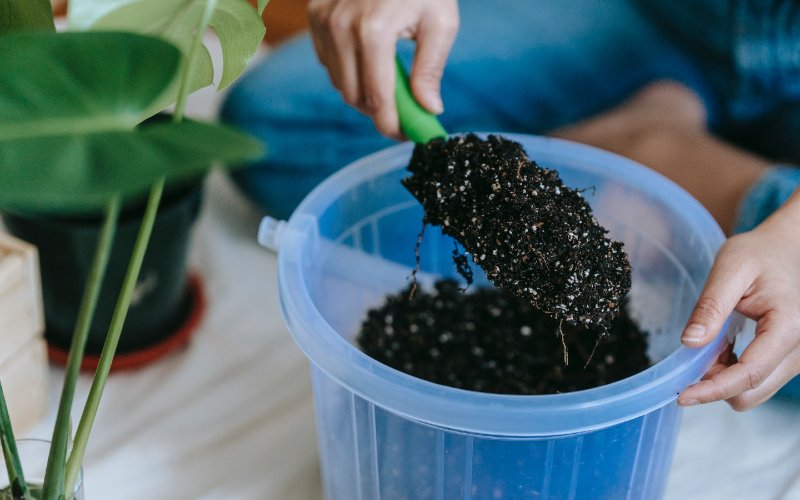How to Get Rid of Mites in Potting Soil (6 Clever Tips)
-
Ed Malaker
- Last updated:

Many kinds of mites can live in your soil, and most benefit the plants growing outdoors. However, most people don’t want bugs roaming around inside their houses. If you have problems with mites and need help removing them, you have come to the right place. Here are several tips that you can follow to eliminate them and prevent their return.
The 6 Tips to Get Rid of Mites in Potting Soil
1. Re-pot Your Plants

Re-potting your plants is the best way to remove dust mites, and your plants will enjoy fresh soil. However, it’s also the most dangerous method because it can damage the plant’s roots. To re-pot the plants safely, carefully remove the plant from the pot, and shake out as much soil as possible to eliminate the mites. Ensure that no soil remains in the pot before adding new potting soil and re-planting.
2. Remove the Top Layer of Soil
Fortunately, most mites stay close to the surface, so if you are afraid of re-planting or don’t have enough soil to re-pot, you can simply replace the top layer. To do so, use a spoon or small scoop to remove the top 1–2 inches of soil along with the mites. When finished, replace the soil with a fresh supply.
3. Use Commercial Spray

If re-potting and removing the top layer of soil is not possible, you can try a commercial spray. It will contain an insecticide that won’t harm the plant but will kill insects, often in all stages of life. The downside is that some sprays might have ingredients that aren’t safe for pets, so you will need to be careful when using them. Their effectiveness can also vary from brand to brand, so you will need to look into the reviews of any product that you intend to purchase to make sure it works. In many cases, you can spray the soil directly to kill the mites, and you will often need to spray the leaves and stems.
4. Use DIY Spray
If you like DIY projects, you can create a DIY spray using essential oils that will help kill mites and prevent them from returning. Tea tree oil is especially effective, and mixing a teaspoon into a large spray bottle filled with water can be a great way to eliminate mites without damaging the plants.
5. Use Hydrogen Peroxide

Adding 3% hydrogen peroxide to the soil, allowing it to sit for several minutes, and then watering the plant heavily to wash it away can be extremely effective at killing mites and other small insects at all stages of life. However, hydrogen peroxide can damage certain plants, so you must test it on a small part of the plant before adding it to the soil.
6. Choose the Right Potting Soil
Unfortunately, the most common way that mites find their way into indoor pots is that they are already in the potting soil that you purchased. Many potting soils include compost, bark, and other organic ingredients that can provide essential nutrients but are also a breeding ground for small insects like gnats and mites. Choosing an indoor potting mix that doesn’t contain these ingredients will reduce the risk of mites in the soil.
Frequent Asked Questions
Do mites bite humans?
Fortunately, most mites don’t bite humans. Instead, they feed on dead organic matter in the soil, which helps break it down so it can release nutrients that plants need.
Are mites bad for plants?
Most mites stick to the soil and eat its organic matter. However, some mites, like the spider mite, will feast on the leaves, damaging the plant and slowing growth.

What causes soil mites?
Many soil mites come from purchased potting soil. Also, most are microscopic, so you can’t see them until they infest the pot. Since they are so small, many can travel through the air, landing on your plants by accident, especially if they are near a door or window. If you tend to your indoor plants after working in the garden, you might have small insects on your hands.
Can I prevent mites?
Mites do not like strong smells, so sprinkling cinnamon or laying a piece of garlic on top of the soil can help deter the insects from making a home there.
Summary
The best way to eliminate mites from your potting soil is to re-pot your plant in new soil after discarding as much old soil as possible. Since mites don’t usually damage plants, the problem soil can make a great addition to the garden. If you don’t want to re-pot, removing the top layer of soil is the next best option, followed by a commercial or DIY spray. Taking the time to choose potting soil that doesn’t contain compost and bark will help reduce the risk of having a problem with soil mites, and sprinkling garlic or cinnamon on top of the soil will help deter any late arrivals.
Featured Image Credit: M. Schuppich, Shutterstock
Contents
